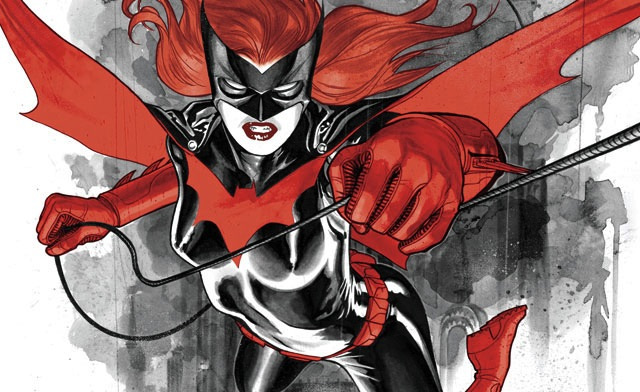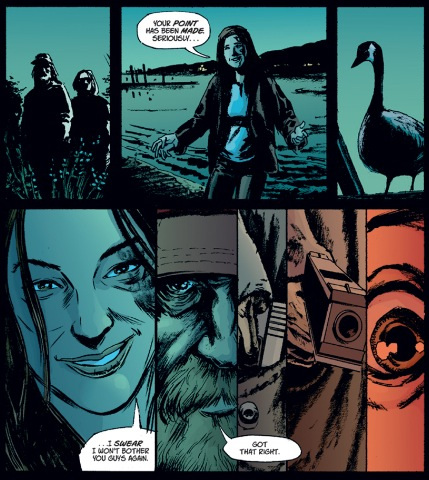Super-heroines, stains and all

My favorite comic book characters have invariably always been the ladies. Maybe because there were less of them when I was growing up. Maybe because their costumes were more fabulous than those of their male counterparts. Probably because, when written with care, the super-heroines always seemed more intuitive, more vulnerable… just more real than most of the heroes gracing the comic book stands. It was great to see Superman save the world every once in a while, but on a monthly basis, it made him a little smug. I’m still not sure if it was sophisticated writing (or a male-dominated field trying to keep women in their place), but the super-girls of yesteryear never seemed smug. They faced real challenges and had to think creatively to get out of a jam. Their successes were all the more inspiring to me for the difficulty faced in achieving them.
I like to think we’ve come a long way (baby) since I was a kid plopping down 60 cents for the latest Justice League. Unfortunately, something new every day makes it clear that the portrayal of women in comics is still a work in progress. Some writers are consistently getting it right, though. Notable among them is Greg Rucka. You can throw a dart at his bibliography and be certain you’ll find a woman who is more complex, original and compelling than pretty much every other comic book character around. He’s written a string of them, from Carrie Stetko (Whiteout) and Tara Chace (Queen and Country) to Renee Montoya (Gotham Central and The Question) and Wonder Woman herself. All of them different from each other and, in cases where they are not creator-owned, grown beyond how they were penned before Greg got his mitts on them. And none of them leap into graceful legitimacy either. They’re imperfect people, and gloriously so.
Nothing says flawed like getting literally shot down in the first five pages of your story. This is where we meet Dex, the lead character in Rucka’s limited series Stumptown, published by Oni Press. Dexadrine Callisto Parios is a Portland, Oregon P.I. in the not-so-grand tradition of rough-edged, down-on-their-luck detectives that peppered 1970s television shows. She’s broke from gambling debts, a smoker, a drinker, and has what can gently be referred to as a smart-mouth. But Rucka’s slow, ambling depiction, combined with the rough and moody lines of artist Matthew Southworth, takes Dex immediately from sad case to compelling protagonist. I’m not even sure I’m rooting for her so much as compelled to find out what she’ll turn up next.

Not that she needs my encouragement. Almost immediately, Dex throws herself into what Rucka endearingly titles, “The Case of the Girl Who Took her Shampoo (But Left her Mini).” Sure, she has a little financial motivation, but it becomes clear early on that the integrity of her work grounds her and pushes her onward without much promise of glory. This Portland is a dark place, rendered beautifully in somber blues and tans, with guys waiting around every corner to threaten, beat or bruise anyone in their way. This is a dirty town, but clearly Dex has learned how to hold her breath and swim in the filth, not to mention take a punch.
Even in what I think is Rucka’s smartest scene, where Dex is finally getting the upper hand on an opponent (albeit over the phone), she still ends up spilling a Styrofoam cup of hot coffee all over her self. And it’s neither humiliating nor heroic — it’s Portland and it’s Dex’s luck. Even when the story is going her way, she’s not going to come out of it with a metaphoric cape and boots or the adulation of millions. At best, she’ll get by, and that seems enough for her. And me too.
Not that a cape and boots is the key to happiness, mind you. In another stroke of genius, Greg Rucka pens the critically acclaimed (and no less complicated) Kate Kane in DC Comics’ Batwoman: Elegy. Originally published monthly in Detective Comics, pushing aside her long-published namesake from the starring role, Batwoman is the tale of yet another crimefighter stalking the night in Gotham City. What differentiates Kate from the Batman himself is that she never seems to take her fight for granted. Sure, she puts on the same grim façade when taking down thugs in a back alley, but she has doubts and wounds that nag at her when the costume comes off. And not just bruised ribs either. In an early scene in the collection, Kate meets her girlfriend for breakfast after a “night on the town” and no amount of swagger is going to stop the obvious, if incorrect, assumptions from occurring. Bruce Wayne may have girls falling all over him, but Kate’s interests are definitely ready to walk away from socialite shenanigans. And the relationship is no ruse; it obviously still matters to Kate.

As time goes on, the story spirals into something much more damaging than a spurned love affair, and here the chaos of Kate’s past begins to take a physical form. There has been a lot of media talk about Batwoman’s debut as a so-called “lipstick lesbian” and some about her history including a dishonorable discharge from the U.S. Military Academy under “Don’t Ask, Don’t Tell.” Neither of these even begin to compare to what Kate discovers about her past and how it reframes her actions in the heat of battle. These moments wrench the heart out of the character, but the phantom pulse left behind is still enough to keep Kate on mission and me frantically turning pages.
Punctuating these moments with his exquisitely detailed style, J.H. Williams pencils the most complex comic book pages I have ever encountered, and all with considerable grace and easy flow. Every two-page spread is not just a masterpiece in itself, but a visual depiction of Kate’s state of mind. Items break across tightly structured panels and the pages themselves give Kate’s movements a sharpness, dragging the reader into the action. When bombs go off, all the panels shake, and my sense of security in the story goes away. Thoughts bleed from panel to panel and suddenly I’m not so sure Kate is on top of her game, no matter how cool an exterior she projects. I’m feeling a little delirious and I’m only along for the ride.
So why does Batwoman work for me when so much of the story is her getting beaten down? I have the same reaction after Dex gets a black eye or kicked in the ribs. Kate retreats, bandages her wounds (physical and otherwise) and comes back the next night, never knowing when to quit. She’s smart, prepares as much as possible (her accumulated tech rivals any Batcave denizen’s), but when the time comes, she’s out the door no matter what the risk. There is integrity to her mission and drive that supersedes trauma, and she doesn’t need to be the perfect heroine to display it. All her vulnerabilities make her a better character, a better super-heroine, and a better woman for me to come back to read every month. More of this in my pull box, please.
—
Matt Santori-Griffith owns one business suit, three pairs of shoes, and over 15,000 comic books. He works a day job as an art director for several non-profit organizations, but spends his dark nights and weekends fighting the good fight on Twitter.com in the guise of @FotoCub. He has not yet saved the world, but isn’t giving up quite yet.
Comments
7 Responses to “Super-heroines, stains and all”Trackbacks
Check out what others are saying...-
[…] Alpha is the first book in a new series for Rucka, who not only wrote Gotham Central and Batwoman’s run in Detective Comics, but also my favorite novel series of all-time starring Atticus Kodiak (Keeper, Finder, Smoker, […]
Great article, Matt.
fantastic read, and i’m not even into comix that much. sounds a lot like pulp detective books from the ’30’s though, which i am into. looking forward to your next installment!
Knowing your tastes, Pete, I suspect you would be completely wowed by the design of the Batwoman art, but blown away by the story in Stumptown. Not that Stumptown is any schlub design-wise either. Even the paper the hardcover is printed on is perfectly chosen and adds to the experience of reading.
Well done Matt! Congratulations!
Matt,
Excellent writing! I haven’t picked up a comic book in a very long time, but after reading this
I just might have to visit the local comic book shop!
I’m still a fan of the Batwoman monthly in the new 52, but I think it really does miss Rucka’s writing. It moves a lot more slowly, although J. H. Williams’ art goes a long way to make it feel like you’re inhabiting every minute. It’s also kind of amusing to read it as basically the same as it would have been before the new 52. Which speaks really well of Kate Kane–she was new continuity before the new continuity even existed. :)